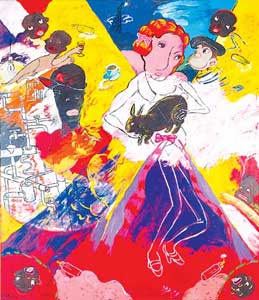Visual Syncopation: Paintings by Robert Colescott
BY PETER SELZ

April in Paris (1998), by Robert Colescott. Acrylic on canvas, 84 x 72 inches.
Ten years ago Robert Colescott represented the United States at the Venice Biennale. Rarely was there a solo exhibition at the American pavilion and it was even more amazing that this honor was awarded to an African American painter. The show was very well received and after it closed at the Giardini Publici it travelled to museums in this country and was seen at the Berkeley Museum in 1999.
The current exhibition is a retrospective of the last 10 years. Most of the works have not been shown before. In his painting, George Washington Carver Crossing the Delaware: Page from an American History Textbook (1975), which ridicules the kitschy and overexposed history painting by Emanuel Leutze, it is G.W. Carver, the black peanut farmer in the general’s uniform, who stands up in a boatload full of “darkies,” frolocking in their ride across the river. It was works such as this, which made Colescott into a celebrated artist, who produced expressionist paintings that were simultaneously hilarious and perturbing.
Over time, his work has become more painterly and gestural while retaining their narrative message. What we see in his late work is a weighty manipulation of pigment, the palpitating vitality of paint which is used to tell his stories—some of them about social justice or the lack thereof.
Colescott was born in Oakland and, after having studied in Paris, came to Berkeley as a student and then as a teacher, but his family’s roots are in New Orleans, the birthplace of jazz. There is a large work in the show, called Ponchartrain (1997), produced way before Hurricane Katrina, which is imbued with a visualization of jazz. It consists of four congruent panels and has two revolvers aiming at two paint buckets with SEX and RACE written on them. “Sex and race are my raw materials,” he said, “that’s why they’re in the paint pot.” But there is more. In an interview published in the catalogue of this show he also speaks of the essential ideas in his paintings: “cultural/social criticism along with personal/ individual identity” as well as “shapes, color and surfaces.” Robert Colescott’s late paintings show the world and its problems as a great carnival.
